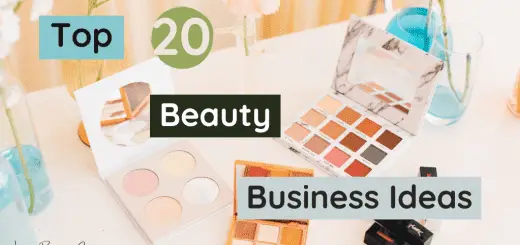How To Start A Profitable Art Business In 9 Steps
The art world is booming thanks to the creative people around the world. It is amazing when you think that you can turn your art hobby into a profitable business. You have the creativity and the enthusiasm to do so. If you have ever thought about selling your art to make good money? How to start a successful art business? This article will answer all your questions.
Many people successfully started art businesses and earned six figures. Any person with creative talent and the readiness to sell their products to their niche market will become a successful business owner. You have the skills and the want. You can do art like a professional and you want to bring your creations in front of as many eyes as possible.
But you need to remember that establishing your brand in the art world and making a good living from your work is not going to happen overnight. It takes good planning, effort, time, and a commitment to lifelong learning.
The best thing is that you can start your art business as a part-time business and later, you can decide whether you want to work on it full-time or treat it as a hobby that makes you extra income.
So, how do you begin?
Here is the Nine-Step Guide to Start A Profitable Art Business.
- Step 1: Select The Art Niche, Target Market, and Product Offering
- Step 2: Create Your Brand
- Step 3: Define Supply Sources
- Step 4: Choose Sales Strategy
- Step 5: Select Funding Method
- Step 6: Establish Business Entity Structure, Business Registration, and Licenses
- Step 7: Work On Tax and Insurance
- Step 8: Develop Consolidated Business Plan
- Step 9: Start Your Business and Learn From Failures
Step 1: Select The Art Niche, Target Market, and Product Offering
Starting an art business means there is huge potential with the creativity of products. There are many different niches/products in the art world. Following are some main products available,
- Acrylic Paint
- Art Sell
- Candle Make
- Clothing Design
- Digital Advertising Design
- Fashion Design
- Floral Design
- Interior Design
- Logo Design
- Mural Paint
Check out the 40 Most Profitable Art Business Ideas which will help you further to choose the products/niches which most suitable for you.
Choosing a niche market is important since each market has pros and cons including specific expenses, pricing, and competition which are key factors for your business success. The industry experts recommend first focusing on a single or few products that you’ve already mastered, well know about, and develop that product uniquely to attract customers.
As an example, let’s say you have mastered digital advertising designs. There are different advertisements like Facebook posts, Pinterest pins, Banners, Cutouts, etc. But it is still technically one type of product and you can master unique digital advertising designs.
Also, there are two types of businesses available for Art,
- Create art products based on the customer-specific requirement.
- Create art products you wish and sell the product to customers.
If you are creating art products based on customer-specific requirements, then you need to understand the customer’s taste of art well. Do they prefer abstractionism, realism, or impressionism? Each customer segment has a different unique taste of art. Maybe everyone does not like your artwork, but there will be certain customer segments who love your artwork. Understanding of this gradually develops with the experience you are getting throughout.
If you are creating art products you wish and selling those to customers, then product differentiation is a key success factor. You should think to differentiate your products from the competition to attract a unique customer base. As an example, don’t limit yourself to just one single theme or color combination. Think differently and produce various art products. Customers will then have a diversified choice to buy.
You have to consider your skills as well as market interest. As an example, research about the trends and fashions in the industry now. A Facebook advertisement post that you really like a few years back will not trend now. Things are quickly changing in the art world.
Step 2: Create Your Brand
Branding is a vital part of any art business. There are many established businesses in the art world and you will compete with them using your branding. Branding represents the credibility of your business, which helps to build a strong relationship with your customers.
A brand is mainly about the business name, slogan, vision, logo, and color theme. These are the things that your customer first see in your online business. Those should be attractive, professional as well as unique.
The important part is to have an attractive, unique, and relevant business name. Please check with your secretary of state’s website to cross-check whether your chosen business name is already in use. After that, you can consider reserving your business domain name and social media page names to establish your brand.
Strong branding helps you to build a powerful connection with your audience to turn them into loyal customers.
You may refer to the below article which published by the United States Small Business Administration (SBA),
How To Choose Your Business Name – Article Published By Sba.gov
Step 3: Define Supply Sources
Quality sourcing is a key area for the success of your art business. The materials you use should be professional grade to produce products that won’t fade quickly. The type of sourcing varies with the niche that you have chosen. You need to consider cost, quality, and time factors.
You need to have a good relationship with the suppliers in your area and understand how you could get your supplies, how much do those items cost, what is the expected quality, and how long they take to deliver.
You can always try to negotiate with the suppliers based on a long-term business plan. It will be a win-win situation for both parties. It will be easy for you to work with a few supplies that you trust, which does not compromise the quality of materials.
Keeping an inventory is a good idea, which should be based on the market demand that you forecasted. As an example, most art niche sales increase during the special seasons. So you need to identify the forecasted sales and get the supplies to be ready with the demand.
Step 4: Choose Sales Strategy
The biggest question in sales strategy is where to sell. There are many ways to sell your art products to customers,
- Rent / buy a shop in a Good Location
- Register with an eCommerce online platform and create a virtual shop/store to sell – You can register with leading online platforms like Etsy, eBay, Aftcra, Storenvy, and Zibbet.
- Create your eCommerce platform – You can create your eCommerce Platform using Shopify, Magento, Wix, and PinnacleCart.
You can open a physical store to establish your brand and promote your products. This will help to attract a unique customers base for your products.
If you are choosing to start an online business, the best approach is to register with an eCommerce online platform to gain a customer base, establish the brand, gather certain profits, and then you can consider creating your eCommerce platform. Many art businesses also operate with physical shops and virtual shops (eCommerce) both.
The best way to benchmark the minimum price of your products is which first decide what hourly wage you would like to give yourself, multiply that by the number of hours utilize for your product, and add the cost of materials. This should give you a fair minimum price for your work to break even your cost. Whatever the price you are selling beyond this rate will be the profit.
Also, you can do a competitor product pricing analysis to benchmark your pricing. You have to compromise a bit on your profit to make your product pricing less than the competitors to attract initial sales. Providing spontaneous discounts is the best way to attract customers to get new sales.
Social media platforms are one of the best ways to promote your products. You can create a Facebook page, Pinterest profile, Instagram account, Twitter account, and LinkedIn page to showcase your artwork. Also, youtube is a good way to demonstrate your talents and products to your customers.
Step 5: Select Funding Method
There is an upfront cost required when starting a business. For an art business, the Initial investment required is comparatively low but it could be considerable.
You are fortunate if you have some capital saved in your account to put those as an investment. But if not, you can consider the below funding methods,
- SBA Loan
SBA loans are guaranteed by the U.S. Small Business Administration and issued by participating banks. These SBA-backed loans have flexible terms, low-interest rates, and it is easier for small businesses to get the funding they require.
- Term Loan
You can get a term loan with a lump sum of cash upfront in exchange for specific borrowing terms with interest rates. You have to agree to pay a fixed amount over a certain repayment period with a fixed or floating interest rate.
- Microloans
Microfinance provides loans to small businesses or individuals, who traditionally lack access to banking and related services. This is a less difficult route to access startup business loans. Microfinance institutions offer loans with little to no assets.
- Credit Cards
Certain banks allow you to borrow against your credit card limit and then pay back monthly over a set repayment term. This is one of the easiest ways to obtain a small loan.
Step 6: Establish Business Entity Structure, Business Registration, and Licenses
- Business Entity Structure
Business entity structure is an important decision to make in your art business journey. This impacts the operational work of the business like tax policies, operation of the business, and also legal terms.
There are mainly four types of business structures available as follows,
| Business Structure | Ownership |
|---|---|
| Sole Proprietory | Single owner for the business |
| Partnership | Two or more people share the ownership |
| Corporation | One or more people (single owner or ownership share) |
| Limited Liability Company (LLC) | One or more people (single owner or ownership share) |
Sole proprietary is the most famous business structure because it’s the easiest and most straightforward to set up the art business.
For each of the above business structures, there are certain liability responsibilities attached. As an example in a sole proprietary business structure, there is unlimited personal liability, but in Corporation or LLC, owners are not personally liable. Please note that the liability, ownership rules, and tax policies for each business structure can vary by state and country.
The details mentioned in this article are written as a general guideline. Please refer to the information provided by state authorities, business attorneys, or tax experts for more information to choose the right business structure for your art business
- Business Registration
You need to register your business name to make it a unique legal entity. There are mainly four ways to business registration, each way serves different purposes,
- Business entity name registration in state level
- Trademark (federal level protention)
- Doing business as (DBA)
- Web domain name registration (protects your business website address)
- License and Permits
Most businesses need a combination of licenses and permits from both federal and state agencies. It may require multiple business licenses at the state, federal, and local levels. Please check with the respective authorities for more information on this.
Below article of US SBA is a great resource to understand about licenses and permits,
Apply for Licenses and Permits – Article Published by US SBA
Step 7: Work On Tax and Insurance
- Tax
Obtaining a state tax ID and federal tax ID is a must for the business, which is also known as an Employer Identification Number (EIN). This is a unique identifier number for your business to help with your state and federal tax payments.
Please refer to the state and federal respective authorities for more information since this varies from each country/state.
- Insurance
You may also need good commercial property insurance. When an unforeseen sudden incident happens on damaging your business assets, commercial property insurance helps protect a business by paying for all or part of costs. This will reduce your business risk of sudden incidents. You have to carefully look into the policy requirement mentioned in the insurance to verify whether it is the most appropriate one for your business.
Business lawyers usually provide consultancy on all of these aspects like business structure, registration, licenses, tax, and insurance to ensure you meet all the regulatory requirements to start your art business legally.
Step 8: Develop Consolidated Business Plan
A business plan consists of many things connected to your business. It contains a mission statement, what types of art products offering, competitive advantages of your products, your industry outlook, target market, and competitive position. These are the sections of a strong business plan that will help you to keep your art business growing.
You don’t want to create a formal business plan to start your business unless regulators require it. But you need to understand the above-mentioned aspects of your business to make this a successful one.
As an example, competitive research will show you what other businesses are doing and what their strengths are. Why your competitors are successful? How you can make your art company successful? What are your complete marketing strategies? Analyzing these questions will help you to be more successful than your competition.
You can visit art shows, or browse art marketplace websites like Etsy and Amazon. See what are the art products offered in your niche. See the best-selling items. See the customer review comments for those products. You can understand more about your customer expectation and competition by doing these things.
Also, you can consider creating your financial statements like income statements, balance sheets, and cash flow statements. This will help you to view different financial aspects of your company. As a starting point, you can start with a simple excel or google spreadsheet to record your transactions (sales, expenses, assets, liabilities, etc.).
You can also think about your strategic partners like suppliers and subcontractors. You should have a good strategic partnership with your partners to be successful.
Step 9: Start Your Business and Learn From Failures
You now know your art niche, created your brand, created the business entity, know well about the supply strategy, decided the sales strategy, fund your business, and have an idea about your business plan. Now you have left only to create art products and sell.
Success is never guaranteed the first time you are doing any work. It may be facing an exam, playing a game, or starting your online art business, there is no assurance that you will succeed in your first attempt.
But experience in failures pushes you to go after your target. You will keep trying until you get it right.
You need to carefully look back on your failures. You have to analyze in-depth what you did wrong, what causes the failure, and then decide what changes you should do to be successful on the next attempt. This is an iterative process. The wisdom of learning from failure is incontrovertible.
When a baby is first learning to walk, he/she is going to fall many times. This is a failure, but one day the baby will walk. He/she might fall many times, but he/she will surely walk. We all know that failing while learning to walk is just a part of everybody’s life. So, why isn’t a failure at other things treated this way? Baby is learning from his/her mistakes and trying to walk somehow, you should also learn from your mistakes while facing the failures to be successful.
“Make Mistakes, Learn From Them, and Move On”
We wish you all the very best in starting your art business.
Want to Start Your Own Business?
Check out below other Articles to get Resourceful Information,


